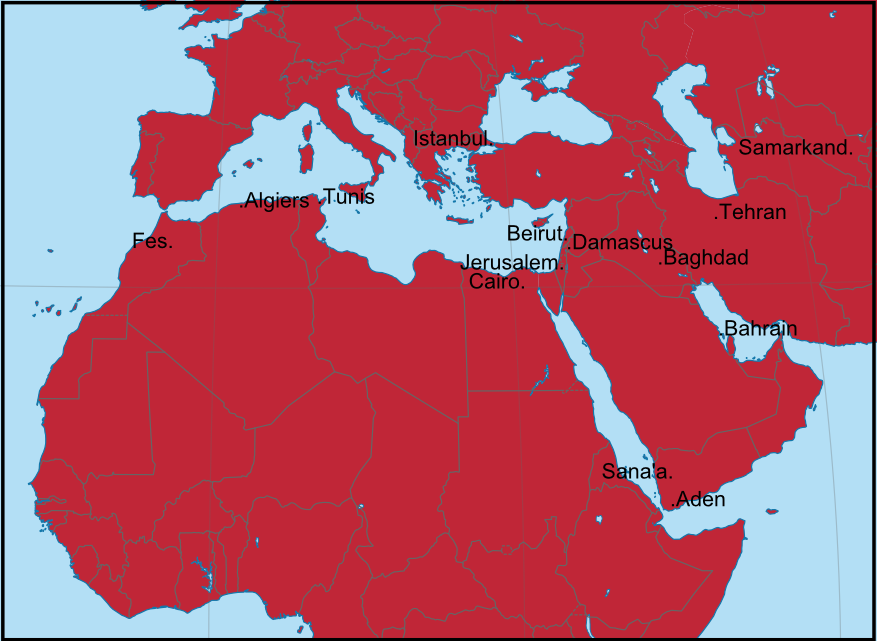From the First Caliphs to the First World War
I wanted to understand the history of the Middle East better, so I made the following timelines. Hopefully some readers will find them informative, too.
Introduction
If you turn on the news, you can see ancient cities like Aleppo, Sana'a, and Mosul being ravaged by war. The present conflicts did not come out of nowhere—rivalries between Arabs, Turks, Persians, and outside powers have been a recurring feature of the region. Understanding some of the history can make the present a little less mystifying (maybe). Plus it's fascinating in many ways for its own sake.
History occurs in 4 dimensions; it has spatial and time-based aspects. This makes it hard to visualize. In this post, I've drawn timelines for a number of different cities stretching from North Africa to Central Asia and placed them in parallel. This allows seeing what was going on along the shores of the Mediterranean at the same time Genghis Khan was pushing through Central Asia, for example.
To orient the following timelines, here is a key map (adapted from a file on Wikimedia) showing the locations of the cities I used:

I tried to pick cities that have long histories (so places like Dubai and Tel Aviv didn't make the cut). Some of the timelines also include a few events from nearby places (e.g. Kairouan with Tunis, Kufa with Baghdad, Rey with Tehran, Bukhara with Samarkand).
The timelines start with the assassination of 'Ali ibn Abi Talib in 661 A.D. and the subsequent start of the Umayyad Caliphate ('Ali was the fourth and last Rashidun Caliph, while the Umayyads had the first dynastic caliphate). They end with the end of World War One and the dissolution of the Ottoman Empire around 1920.
For each city, I've included the timeline followed by some links to people, places, events, etc. that were mentioned; general reference pages are linked in a section at the end. My source for this post was Wikipedia.
I made the timelines using Inkscape, as I've done for some other infographics on my blog (see 1, 2, 3). I think I uploaded a suitable resolution to read, although you may need to zoom in or open the images in a new tab, especially if you have a small screen.
The Timelines
History of Fez / تاريخ فاس

- Berber Revolt
- Al-Qarawiyyin, the world's oldest university library (plus see photos here)
- Avempace
- Almoravids & Almohads
- Moroccan dynasties
History of Algiers / تاريخ الجزائر

History of Tunis / تاريخ تونس

- Ifriqiya province
- Kairouan
- Ibn Khaldun
- Hafsids
- Louis IX of France
History of Cairo / تاريخ القاهرة

- Mamluks
- Fatimids
- Saladin & Ayyubids
- Ibn Al-Haytham
- Ibn Yunus
- Hametus
- Qalawun complex
- Mohammed Ali
- Napoleon in Egypt
History of Jerusalem / تاريخ القدس

- The Crusades
- Battle of Ain Jalut against the Mongols
- The Golden Gate
- Judah the Pious
History of Damascus / تاريخ دمشق

- Umayyads
- Al-Shatir & Al-Khalili (astronomers)
- Lawrence of Arabia
History of Beirut / تاريخ بيروت

History of Istanbul / تاريخ إسطنبول

- Various sieges
- Suleiman the Magnificent
- Topkapi Palace & Grand Bazaar
- Attempts at conquering Vienna
- Spread of coffee
History of Aden / تاريخ عدن

History of Sana'a / تاريخ صنعاء

- Zaydis and ruling Imams in Yemen
- Al-Hasan Al-Hamdani (geographer)
- Sulayhids
- Rasulids
History of Bahrain / تاريخ البحرين

History of Baghdad / تاريخ بغداد

- Book of Ingenious Devices
- Mongol siege/sacking
- Fought over by the Ottomans and Safavids
- Jabir ibn Hayyan (chemist/alchemist)
- Al-Kindi
- ibn Duraid (linguist)
History of Tehran / تاريخ طهران

History of Samarkand / تاريخ سمرقند

- Timur (a.k.a. Tamerlane) and his empire
- Babur and the Mughal Empire
- Kara-Khanids
- Bukhara Khanate and Emirate
- Shah-i-Zinda and Registan complexes
- The "Great Game" between Russia and Great Britain in Central Asia
Discussion
There are a few interesting things I noticed in preparing these timelines:
- Ottoman rule lasted for five times longer than the Western colonial period for many of these cities
- Throughout history, there have been waves of invasion from the East: by Mongols, Seljuks and other Turkic/Persian peoples, etc.
- The small countries in the region, like Lebanon and Bahrain, do have some historical distinctions from their neighbours
- We don't hear enough about the Mamluks, I feel, relative to the extent of their rule
- Russia has been a constant presence to the north of the region
- The most historically influential cities above were probably Constantinople/Istanbul, Cairo, and Baghdad
I could have included more cities, but I think I achieved decent coverage with the ones I selected.
General References
- Timeline of Fez
- Timeline of Algiers
- Timeline of Tunis
- Timeline of Cairo
- Timeline of Jerusalem
- Timeline of Damascus
- Timeline of Beirut
- Timeline of Istanbul
- Timeline of Aden
- Timeline of Sana'a
- Timeline of Bahrain
- Timeline of Baghdad
- Timeline of Tehran
- Timeline of Samarkand
- List of largest cities in history
- Ottoman conquests
- Lists of caliphates and a map of early expansions
- Umayyad and Abbasid family trees